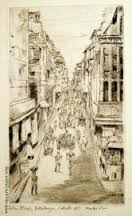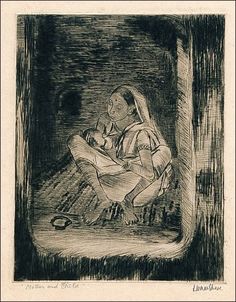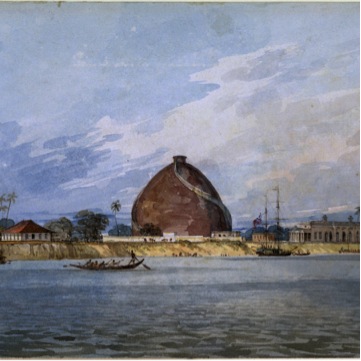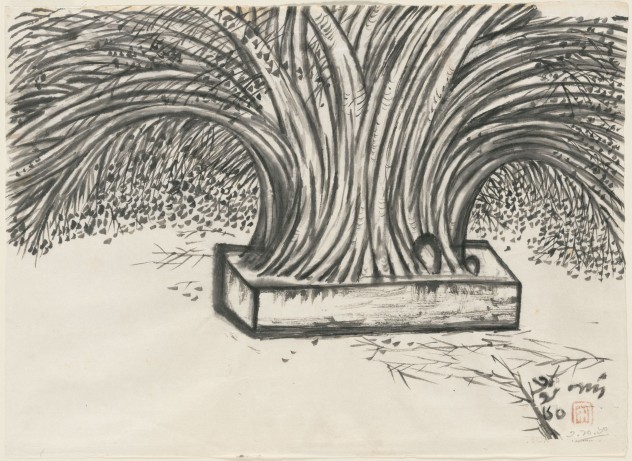Gaslight and railway communication with Gaya, claimed the reporter who communicated the following incidents to the public, had greatly attenuated the ability of spirits to interfere with the domestic affairs of the inhabitants of the City of Palaces. Gaya, as will be familiar to many, is a site of pilgrimage. Many Hindus, particularly in eastern South Asia, hold that performing special funerary rites at Gaya finally liberates souls that have been unable to break the bonds of attachment despite death. So it was natural to think that as more people began traveling to Gaya by train to perform such rituals, the City’s specters achieved liberation in greater numbers. While the railways liberated the spirits, the incandescence of gaslight rendered those that remained invisible.
And yet, not all spirits departed from gaslit Calcutta. In fact, it was one of these resolute spirits that had set the metropolis abuzz in the late 1870s. No. 3, Sukea Street was where it made its spine-chilling presence felt. Located at the heart of the respectable section of the “native town” (the city of course was still roughly divided into the “native” or “black towns” and “white towns”), the premises were home to a certain Mr. N who was the Manager (Chief Executive Officer in today’s parlance) of a large and wealthy Zamindari estate in the nearby district of Jessore. Expectedly, with a good and well-paying job, Mr. N also presided over a sizably sprouting family.
Amongst Mr. N’s children was a daughter who appeared to contemporary eyes as a “sweet” young girl with a “gentle disposition”. When she was about 12 or 13 years old, in keeping with local custom of the day, Mr. N married her off. The marriage was lavishly celebrated and by all accounts the match was a good one. The groom was only a few years older than the bride and reportedly devoted to her. And yet, tragedy cleft the promise of a blissful conjugality. The young daughter did not seem to adjust very well to marital life. She began withering away and, to the utter consternation of her parents and young husband, perished in less than a year.
Prior to her marriage however, the daughter had been exceptionally fond of a particular younger brother. As is often the case in large families, sibling love is uneven in its distribution. Bonds of fondness are forged between particular siblings over and often at the expense of other siblings. It is also well-known in Bengal that when a relative or friend passes away, those they loved the most remain vulnerable for a year or two after the death. It is believed that in its afterlife, the departed soul seeks the company of those it was most attached to in its life. Perhaps it was this vulnerability that led to the young boy falling gravely ill within six months of his sister’s passing.
Initially, no one considered the illness a serious one. The boy was down with fever, but fevers were common in Bengal and young children kept getting them through childhood. But when repeated visits from several physicians and multiple doses of medicine failed to make any dent on the illness, the family began to worry. Distressed beyond measure, Mrs. N, the boy’s mother, began personally nursing the boy day and night. But nothing seemed to work and the fever continued unabated.
One night, as the mother battled sleep and fatigue and kept vigil over her rapidly fading son, she heard the most unusual sound. It was well past midnight and the city was hushed in sleep. No one stirred and not a sound unmuffled. But the familiar quietness shattered when she heard distinct sounds of water being drawn from the well in her courtyard. Of all the likely sounds of the night, this was certainly not one. No one would be hauling water from the domestic well at this hour. Intrigued and somewhat apprehensive, Mrs. N peered out of the window of her son’s bedroom. The night was not only dreary but a dark one – the one that cast longer and darker shadows in the courtyard. Yet, the well was clearly visible and at it, as Mrs. N unmistakably beheld, was her dear departed daughter.
 With a start, she shrieked and in predictably Victorian fashion, swooned. Roused thus from their sleep, the large family came running from the adjoining rooms at the sound of her. But nothing further took place that night. From the following day, however, all hell seemed to break loose. Every single member of the sizable and extended family saw the departed daughter at one point or other. And it was no longer just on dark and dismal nights. She now appeared at all hours and in all places in the family home. She even began directly addressing some of her family members. Most remarkably, she made it absolutely clear that she was terribly lonely in the Great Beyond and could not live without her dear brother. So no matter how much the parents tried, her brother would soon rejoin her.
With a start, she shrieked and in predictably Victorian fashion, swooned. Roused thus from their sleep, the large family came running from the adjoining rooms at the sound of her. But nothing further took place that night. From the following day, however, all hell seemed to break loose. Every single member of the sizable and extended family saw the departed daughter at one point or other. And it was no longer just on dark and dismal nights. She now appeared at all hours and in all places in the family home. She even began directly addressing some of her family members. Most remarkably, she made it absolutely clear that she was terribly lonely in the Great Beyond and could not live without her dear brother. So no matter how much the parents tried, her brother would soon rejoin her.
Despite such horrifying declarations of sibling love, Mr and Mrs N determinedly clung on to hope and tried everything. Even as physicians kept failing to control the fever and the brother succumbed more and more to his sister’s wishes, someone advised the family to bring in exorcists. Several such were invited from various villages with which the family had connections. Yet none could put the specter of the dead daughter to rest. Finally, one of them suggested that the last hope was if someone were to travel to Gaya and perform the funerary rites there to release the daughter from her mortal attachments.
Accordingly, a relative was despatched post haste via train to Patna. The Gaya-Patna line had happily just been inaugurated and so was immediately made use of. It was planned that the relative would journey to Patna and then take the connecting train to Gaya. Given the long and arduous nature of the journey ahead however, the relative thought it prudent to take an extra day and see an old acquaintance who lived close to Patna before proceeding to Gaya the next day. But as he was about to switch trains in Bankipur, though he had no company in the compartment, he heard a voice admonishing him for delaying his sacred mission for frivolous engagements. But the reprimand was not enough. He felt seized by a will stronger than his own that guided him towards the Gaya train right away. Consequently, he reached Gaya late at night and after a restless night performed the funerary rites the next morning.
Back in Calcutta, the distraught family members were further confounded by witnessing a most singular incident that very morning. It was one of those exceptionally still days when even the slightest rustling of the leaves is rendered forbidden. And yet, the pear tree next to the well in the courtyard suddenly started shaking violently. After about half an hour of a seemingly endless commotion, one of the main branches of the tree came crashing down. There was, of course, no explanation either for the commotion or the crash. Upon the relative’s return from Gaya in a couple of days, it became clear from what he stated that the incident of the pear tree coincided exactly with the moment he was performing the funerary rites in Gaya that day. Be that as it may, ever since the branch of the pear tree crashed, it felt like a heavy weight had lifted off the family. By that evening, the young son’s fever began to gradually subside for the first time after a little more than a month.
The case created enough of a stir to be reported in the English language press of the time. Notwithstanding the generous details those press reports have left us, many tantalizing questions remain. How did the family feel about losing their daughter a second time? Did the joy of ensuring their son’s life entirely eclipse the grief of having to force away their daughter’s spirit? Did the boy continue to recover? Did he survive into adulthood? If so, did he still remember his sister? Whose voice was it that spoke within the railway compartment in Bankipur? Was it the daughter herself? Was her spirit torn between the desire to reunite with her brother in death or part with him and life?





Thanks for the great article.